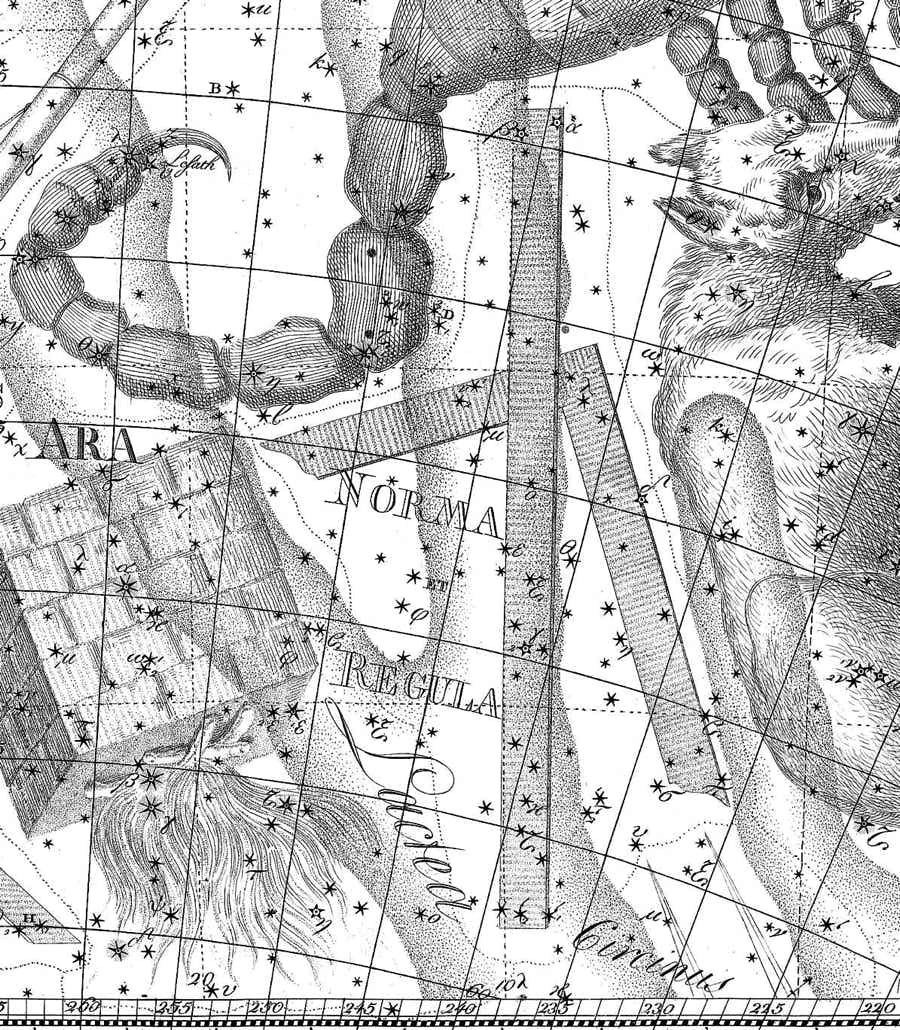
Genitive: Normae
Abbreviation: Nor
Size ranking: 74th
Origin: The 14 southern constellations of Nicolas Louis de Lacaille
Norma is one of the constellations introduced by the French astronomer Nicolas Louis de Lacaille following his mapping of the southern skies in 1751–52. It consists of faint stars between Ara and Lupus that were not catalogued by Ptolemy. On his 1756 planisphere Lacaille called it l’Equerre et la Regle, although in his accompanying star catalogue the name was given simply as l'Équerre. In the notes to his catalogue he described it as representing an architect’s set-square and ruler.
Lacaille placed it next to another of his inventions, the compasses (le Compas, now known as Circinus), and the southern triangle (Triangulum Australe); this latter figure was an earlier invention of the Dutch navigators Keyser and de Houtman which Lacaille visualized as a builder’s level, thereby creating a trio of surveying and drawing instruments. On the 1763 edition of the planisphere Lacaille Latinized and shortened the name of the constellation to Norma; others, though, preferred the fuller name Norma et Regula, as did Johann Bode on his atlas of 1801 (see illustration below). The brightest stars of Norma are of only fourth magnitude and none have names.
In his widely quoted book Star Names, Their Lore and Meaning, the historian R. H. Allen called this constellation ‘the Level and Square’. Allen said that the French edition of Flamsteed’s star atlas (i.e. the Atlas Céleste of Jean Fortin) showed it as Niveau, the level, but a glance at that atlas shows he is wrong. The alternative name ‘level’ was actually applied to the southern triangle, Triangulum Australe. Allen seemingly misread the French map and transferred the name to the wrong constellation, in a reprise of the way in which star names were misapplied through misreadings of maps down the ages. Allen’s error has caused confusion ever since.
Norma, shown as a set square and ruler under the name Norma et Regula on Chart XV of the Uranographia of Johann Bode (1801). Due to changes in constellation boundaries, the stars labelled Alpha and Beta at the top of the ruler are now part of Scorpius, and are known as N and H Scorpii. Click the following link for a modern chart of this region.
Because of changes in the constellation’s boundaries since Lacaille’s time, Norma no longer has stars labelled Alpha or Beta.[note] The stars that Lacaille designated Alpha and Beta Normae are now part of Scorpius, where they are known as N and H Scorpii respectively. Incidentally, Norma shares this distinction with Puppis and Vela, both of which lack stars labelled Alpha and Beta because they were once part of a much larger constellation, in their case Argo Navis; when Argo was split into three by Lacaille, the stars Alpha and Beta ended up in the third subdivision, Carina.
Chinese associations
Although Norma is a modern constellation, its stars are at similar declination to those of its neighbours Ara and Lupus so they would have been visible to the ancient Chinese, as they were to the Greeks. The Greeks did not incorporate any of its stars into their constellations, but the Chinese did. Up to four stars in northern Norma were part of Jizu, a battalion of soldiers, the bulk of which was in Scorpius. Sun and Kistemaker identify the four stars as Delta, Epsilon, Mu, and Lambda Normae. Other sources, while agreeing that stars in Norma were involved in Jizu, differ in their identity and number.
© Ian Ridpath. All rights reserved
Lacaille described Norma as ‘L’Équerre & la règle de l’Architecte’ in the notes to his star catalogue and chart published in 1756. He added that he had also depicted the existing constellation of Triangulum Australe as a surveyor’s level (‘niveau’), thereby completing a trio of surveying and drawing instruments with neighbouring Circinus, the compasses.
Beta Normae was accidentally left unlettered in Lacaille’s final catalogue published in 1763, where it is listed simply as star 1376. It was, though, labelled correctly in Lacaille’s preliminary catalogue and on his charts.




